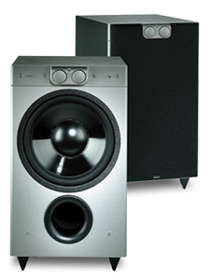![[SoundStage!]](../sslogo3.gif) Getting Technical Getting TechnicalBack-Issue Article |
||
June 2005 Caveat Emptor! Subwoofers, Power Ratings, and the FTC's "Amplifier Rule" -- Part TwoOne of the greatest arguments in the audiophile world is regard power-amplifier ratings. Even with the FTC-amended regulations, people still debate whether comparisons between amps are accurate and if specs are accurate. And such debates can be heated. For example, I recently came across a subwoofer dealer’s website that in bright yellow states: IMPORTANT! "Please be aware that, in some cases, manufacturers severely exaggerate power claims." Power ratings and price are some of the top criteria consumers use when comparing subwoofers. That power -- the raw, basic factor underlying performance -- is a measurement so abused and exaggerated in the industry that it warrants warnings. How is a girl to choose between Paradigm Reference's Seismic 12 and Definitive Technology's SuperCube? Feel the music
I confess to being a Black Sabbath fan, and there is nothing more satisfying than feeling NIB, and I do mean feeling in the purely visceral sense. When the frequency of sound approaches the lowest end of our perceptual range it can be felt and heard. In fact, when the frequency drops below our hearing ability, then it can only be felt. This is called infrasound. How we feel these low frequencies requires a bit of perception theory. Sound travels through the air in a wave of changing air pressures. Our ears sense the changes in air pressure and the signals they send to the brain are interpreted as sound. The lower the frequency, the longer the sound wave and the slower the air-pressure changes. Eventually, at around 20Hz, the sound wave is so long that the air-pressure changes are too slow for our ears to respond. However, if the slow-moving sound wave has sufficient volume, our bodies can feel the air-pressure changes as a vibration. We can feel sound at frequencies as high as 200Hz, and this allows the listener to hear and feel the sound. Subwoofers are dedicated to these very low frequencies. Why subs matter Subwoofers' first rise in popularity was due to those wanting to bang their heads and feel their music, but their use goes beyond that. For any music lover, subs provide an added depth to music that most speakers' woofers cannot add alone. Especially with classical music that uses bass drums or organs, subwoofers make the music sound beautiful and more believable. Subwoofers can also relieve your main speakers of the struggle to reproduce really deep bass. Home-theater enthusiasts also love their subs. In these multichannel systems subwoofers are indispensable for providing the roar and rumble of today’s blockbuster movies. When showing off his new system, my brother played The Matrix’s lobby shootout scene -- again and again and again. He loves the deep sound and power of his subwoofer. With the rise in popularity of home theater, more and more consumers are taking an interest in subwoofers. This group, like my brother, likes it loud, and to make it loud a large amount of power is usually required. Hence, power ratings are extremely important and, unfortunately for the average consumer, extremely confusing and misleading. Wattage James Watt would roll over in his grave to see his simple watt so abused by the audio industry. A watt is equal to one joule per second, meaning that it is the energy expended per second by an unvarying electric current of one amp through a conductor the ends of which are maintained at a potential difference of one volt. The greater the wattage the more electrical energy available to feed the voice coil, so it can more easily drive the loudspeaker’s cone back and forth, creating the sound we hear. This power is what attracts consumers and compels manufacturers to exaggerate the power of their amps and subwoofers. Cunning ruses And there are many methods manufacturers use. First, when performing power measurements they will use unusual operating conditions. Wattage is directly related to voltage. By increasing the voltage of the power source by just a few volts, manufacturers can increase the power output, sometimes by a substantial amount. Of course, consumers do not have the luxury of variable currents, and when they get their new subwoofers home, they perform at a much lower power. Wattage is inversely related to resistance. To boost wattage, manufacturers could measure the power output of the amplifier with a load as low as 0.5 ohms, which wouldn't necessarily be the load that the real driver presents to the amplifier, but will give the illusion of higher power. Consumers must be wary of low-load factors in power ratings. Finally, the test signal can also influence wattage. For example, by reproducing only one frequency the amplifier might be able to deliver far higher power than it could across a wider bandwidth. Consumers must ensure that the complete subwoofer bandwidth -- say, 15 to 150Hz -- is used during power measurements. The wording used by manufacturers can be confusing at best and misleading at worst. Power measurements described as instantaneous peak power (IPP), peak music power output (PMPO), or simply "peak" or "max," should be taken with a grain of salt. These values are usually twice that of the best measurement, the one which most closely describes the subwoofer's true power, root mean square (RMS). RMS is the root of the mean value of the square of wave amplitude. The root is used to find the DC equivalent of an AC quantity. The principle is that power can be correctly calculated for the AC circuit using RMS values. But really all consumers need to remember is that if a subwoofer’s power is not specified as RMS, then they may not get the power they are paying for. The power of a subwoofer is also contingent on its number of voice coils. For instance, a unit with two voice coils uses double the power of one. Therefore, some specifications use this fact to inflate the power measurement. So how does this work? If the spec reads 1200 max watts dual voice coil woofer, first divide 1200 by 2 to approximate the RMS value, and then divide that value by 2 for the two voice coils. You then have the true power of the woofer -- 300 RMS watts. Not nearly as impressive as 1200, is it? Athena Technologies weighs in
I spoke with Joe Fraser, brand manager for Athena Technologies with 17 years’ experience in the audio industry. Athena Technologies is owned by Audio Products International, which also produces loudspeakers and subwoofers under the Mirage and Energy brand names. I asked him what he thought of the subterfuge surrounding power measurements, and he provided an interesting analogy. "[Power measurement methods] are like an old trick used by the American auto industry in the 1960s. When measuring horsepower, manufacturers would disconnect the motor from the trannie and measure the engine’s power without any load. Meanwhile, European auto manufacturers were under different regulations and had to specify engine horsepower with it connected, generating, of course, lower power measurements. Eventually, regulations were established to prevent this, and the playing field was leveled." I asked Fraser if the playing field were to be leveled by the Federal Trade Commission (FTC), what should become the standard power measurement. "This is something that everyone in the industry might have differing opinions on," Fraser responded. "The fact that the measuring techniques can be changed to suit the desired results will make many manufacturers happy. After all, larger wattage claims sound better in ads and on in-store product cards. Who wouldn't buy the 1000W sub as opposed to the 400W sub at the same price? I have seen sales lost to other brands because the numbers on paper looked more favorable, even though the consumer admitted that our product sounded better in the demo. Astounding!" "There will be the informed, discerning consumer," he continued, "who is aware that watts are not equal, and will actually read the specs, assuming they are published, to discover the method of measurement. Audiophiles have always been wary of rated specifications, and they read as well as understand them. For most of the general public, it is a case of buyer beware." At Athena Technologies, subs are measured using the operating conditions the consumer will eventually use. "The way we measure [our subs] is simple," said Fraser, "Using the bandwidth of frequencies that the sub will actually emit, and at the impedance of the subwoofer's driver, we test the RMS rated power of the amplifier. We also measure the peak or dynamic power, which can give the consumer an idea of the subwoofer’s dynamic capabilities." Conclusion Manufacturers that want their measurements to inform consumers, not to simply sell their product, believe that their product’s quality will sell itself. It is frustrating for this group to see competitors’ inaccurate specs. And when educating consumers, all of these numbers and terms merely add to their confusion. It is the FTC’s mission to protect consumers from "unfair or deceptive acts or practices." It is surprising then that they have not provided regulations. The popularity of subwoofers has increased because of home theater -- which the FTC responded to with its amended Amplifier Rule. Why the FTC has not acted is explained by some that high-end audio is too small a market and the FTC is understandably more concerned with large-scale fraud or with products that simply don’t work instead of providing exaggerated claims. The FTC believes that free markets work, meaning that fair competition in the marketplace creates better products at lower prices and encourages innovation. To create this, however, also means that consumers must be accurately informed and that deception and fraud are rooted out. Stricter regulations in the audio industry would benefit everyone, especially the consumer. Until then, when it comes to purchasing subwoofers, caveat emptor. ...Alison Aulph To learn more about Athena Technologies, visit www.athenaspeakers.com.
|
||
|
||
![[SoundStage!]](../sslogo3.gif) All Contents All ContentsCopyright © 2005 SoundStage! All Rights Reserved |

